ABSTRACT
Banana and plantain are popular fruits considered as major staple foods, and provide significant income to farming communities. A handicap to their development and production remains access to quality suckers. However, their diversity is still unknown in Benin. To assess the knowledge on the diversity of local varieties of both dessert banana and plantain at the community level, ethnobotanical surveys were undertaken using participatory research appraisal tools such as direct observations, group discussions and field visits from 119 interviewees living in 63 villages from 24 communes districts in Central and South of Benin. A total of 121 farmer-named banana and plantain varieties (83 vernacular names for banana and 39 others for plantains) were recorded and gathered into 58 differentiated varieties on the basis of the significance of the vernacular name relying on morphological traits and medicinal uses. Southern ethnic groups hold higher local varieties (H = 3.15 bits for the ethnic group Fon and H = 2.09 bits for Wemegbé) due to the high rainfall conditions favorable for the development of banana species than those from Central-Benin (H = 0.64 bits for the sociocultural group Mahi). The main constraints to these crop productions were drought (23.8% of responses), stealing of the whole bunch (19.0%), pests and diseases (14.3%), susceptibility to flood (9.5%) and pseudostem break by wind (7.8%). In situ and ex situ conservation should be undertaken to preserve the varieties cultivated by a few households on small areas defining their vulnerability status as well as those most commonly produced in large amounts.
Key words: Banana, plantain, parataxonomy, conservation, varietal diversity, Benin.
The majority of cultivated bananas arise from the Eumusa, one of the four groups from the genus Musa (Daniells et al., 2001). All Eumusa species are almost completely sterile because of the lack of fertilization so that fruits are parthenocarpic including non-seeded types (Sweenen et al., 1995). Most cultivars are derived from two species, Musa acuminata Colla (the most widespread species of Eumusa and represented by the symbol A) and Musa balbisiana Colla (symbol B). In the tropical and subtropical regions, rural populations depend heavily on various food plant resources to satisfy particular nutritional and therapeutic needs. Banana and plantain are popular fruits, which are considered as major staple food and important components of food security for many households, and provide significant income to the farming community through local and international trade (Crouch et al., 1998). Plantain fruit is rich in carbon hydrate and highly energizing; it is an edible and sweet fruit consumed as dessert or as a cooked crop (plantain and banana). These fruit crops include 90% of banana and 10% of plantain (Lescot, 2006), and represented the second largest fruit crops of the world after citrus with a contribution estimated to be 16% (Debabandya et al., 2010). It represents the fourth world crop (more than 117 tons millions of annual production, Lescot, 2011) after rice, wheat and maize (Lassoudière, 2007). Banana is mainly cultivated for its highly nutritious and digestible mature fruit, which is also considered as a source of energy (Jenny et al., 2003). It is rich in potassium and calcium with low sodium content as well as vitamins A and C, and carotene. However, these component contents vary according to the cultivar ploidy level (Happi et al., 2007; Debabandya et al., 2010). Its richness in glucides leads to its high energetic value close to some large amylaceous products such as yam, sweet potato, taro, and potato (Ongagna et al., 2016). It is consumed under various forms including porridge, chips, crush, and pastries; plantain processed in flour is used to make bread, fritter, foufou (puree from mixing in a mortar of the plantain boiled in water), cracker, cake and to thicken sauces (Tomekpe 2006). Apart from its consumption as fruit, banana is also processed in making local beer in East Africa (particularly in Uganda, Hamilton et al., 2016, Daniells et al., 2001), or to produce alcohol and phytosanitary products. Its importance is expressed through its cultivation in houses as well as in small areas so that fruits and all products are available all through the year. Moreover, in contrast to other crops such as cereals, the cultivation of banana and plantain appears to be a good biological plant species candidate adapted to climate change, because a temperature increase of 3°C remains favorable for their development (Calberto et al., 2016).
With an annual production of 19,000 tons, Benin is a small producer compared to other African producing countries (FAOSTAT 2016). However, banana production is growing each year and large areas are devoted to production mainly in the south and central parts of the country. Unfortunately, little research has been carried out in Benin on these phytogenetic resources often referred to as "miners" crops. There is no report on varietal diversity of cultivated banana and plantain in Benin, as well as the endogenous knowledge related to the production of banana. Recent studies have been undertaken on ethnobotany, production, diseases as well as agronomic performance, morphological genetic variability assessment and their implications for the productivity and sustainability of banana and plantain grown for domestic consumption and trade, improvement and conservation. However, little is known on species’ and cultivars’ vulnerability level considering their production and constraints in diverse cultivated environments following climate deregulations.
To assess the knowledge on varietal diversity of both banana and plantain at the community level and define strategies for its management in Benin, we used participatory research appraisal tools through ethnobotanical surveys. We addressed the following questions: Do cultivated banana and plantain harbor differentiated local varieties? Are there similar local etymological names that would suggest a good parataxonomy? What is the level of varietal diversity according to district? Are there evidence of producers’ varietal preferences criteria and production constraints?
Sampling and area of study
Investigations were made using questionnaire surveys combining many variables, from vernacular names to pests, uses and perceptions (complemented by direct field observations) from 119 interviewees of both sexes from different age classes. They included producers randomly sampled (n = 62), local farmers’ associations and group discussions of people holding on these crops knowledge and living in 63 villages from 24 Communes throughout eight districts in Central and South of Benin where banana and plantain are recognized to be mainly produced (FAOSTAT 2016). Prospected districts are shown in Figure 1. This area is inhabited by nine ethnic groups, among which the most important included Fon, Goun, Kotafon and Adja in South; while Nagô and Fon are predominant in Centre. Annual rainfall ranges from 900 to 1400 mm. Daily relative humidity and temperature vary between 18 and 99%, and 18 and 42°C, respectively; and the yearly average potential evapotranspiration (ETP) is 1550 mm (ASECNA, Agence pour la Sécurité de la Navigation Aérienne en Afrique et à Madagascar, 2010). Southern Benin is characterized by a humid subequatorial climate with 4 seasons of unequal duration, two rainy seasons alternating with two dry seasons. The short dry season is centered on August while the second dry season extends from November to February. Annual temperature ranges from 25 to 29°C. The Centre of Benin is under the influence of transition between the subequatorial and sub-Sudanian climates. The transition is most marked between semi-deciduous rain forests and savanna woodlands, presenting all intermediate aspects between both plant communities.

Data collection
Ethnobotanical surveys relied on socio-cultural profile of the respondents (age, level of education, and ethnicity), banana and plantain locally grown and their vernacular names and etymology, plantation age and status (ownership or inheritance), uses (dessert, food, medicinal ingredient, etc.), food processing, fruit ripening methods, production area, criteria governing preference in breeding schemes, age, socio-economic importance, production constraints, susceptibility to climate deregulation and soil, conservation techniques, and diseases. To limit errors in respondents’ response, the investigation considered uses already documented, especially those for which part of the plant is solicited. Interviews were followed by observations in the farmers’ home gardens/fields for appraisals of traditional morphological descriptors as perceived by local people and for suckers collection for agro-morphological characterization and national collection.
Analysis
An exhaustive list of vernacular names of local species and varieties of banana and plantain was established. Descriptive statistics (frequency, percentage, mean, etc.) were run in R2.12.0 (Venables and Smith 2010) to generate summaries and tables at different scales (villages, departments, and study area). Banana and plantain variety diversity was assessed using several parameters: varietal richness and abundance (at both local and regional levels that is sites and region respectively), while varietal richness, Shannon diversity index (H) according to Frontier and Pichod-Viale (1995) and Equitability index of Pielou (E) were estimated at ethnic group level.
H = - ∑(ni/N)*ln(ni/N), where ni = number of citation of the variety i by the farmers from an ethnic group and N = sum of ni for all varieties quoted within the ethic group considered. The varietal diversity was considered as low if H < 3 bits, medium if 3 < H < 4 and high whether H > 4 bits.
E = H/ln(R), while H represents the diversity index of Shannon and R is the total number of local varieties cited. It varied from 0 to 1. More it is close to 1, more there is a fair citation of varieties within the ethnic group.
Allocated areas (large vs. small; that is, < 0.25ha) and frequency of presence of each variety were used to identify unpopular and/or rare varieties (citation frequency < 0.25 and produced at small scale, often found in a home garden). This led to the identification of varieties potentially threatened from those highly abundant. The software ArcGIS version 10.4 was used to draw the map of the study area.
Diversity, vernacular names and etymology of banana and plantain varieties
All banana and plantain species were designated by the same vernacular generic name by each ethnic group across area of study. Indeed, “Kokoe” in Fon and “Oguèdè” in Nagô languages are used for both banana and plantain. Banana varieties were more abundant than those of plantain, varying from 1 to 13, within and among villages and administrative divisions. At the scale of village, the village named Guémé from district of Zogbodomey is the richest site, harboring 13 local varieties. The district of Dangbo with an average of 11 varieties and the department of Ouémé with an average of 7.12 varieties ranked first, respectively, at the district and department levels. The mean number of local varieties varied significantly with district (p = 0.01) as well as at the department level (p = 0.07; Table 1). A total of 122 farmer-named banana and plantain varieties (83 vernacular names for banana and 39 others for plantains) were recorded from the nine ethnic groups surveyed. Their significance, based on discriminant traits described by farmers, was used to gather them into 58 differentiated local varieties: 16 for plantain and 42 for banana (Table 2).
In total, 15 varieties (25.9% from the 58 varieties recorded) were popular among which five varieties (two plantains and three bananas) economically profitable varieties, were widely cultivated by many households on large scale (> 0.50 ha): plantain of white pulp, plantain of yellowish pulp for plantain varieties, while dessert banana varieties included Planta, Sotoumon, and Gba kokoé. Some rare varieties cultivated by few households (cultivated areas < 0.25 ha) were recorded, gathering 12 plantains with particular traits such as hand number on peduncle, and 26 dessert banana varieties from which many had medicinal uses (Table 2), while others were of poor agronomic performance (e.g., susceptibility to lodging and drought, reduction of the productivity with the age, low market value, pest and diseases).
At the ethnic group level, southern areas of Benin harbored the most varietal diversity. Indeed, Shannon’ diversity index was H = 3.15 for the ethnic group of Fon and H = 2.09 for Wemegbé’ ethnic group, displaying an equitable citation of varieties, E = 0.94 and E = 0.87 respectively. In other words, each variety almost had the similar citation frequency by farmers within an ethnic group. In the opposite, ethnic groups from Centre of Benin such as Mahi, Nagô and Idaasha were less rich especially the sociocultural group Mahi (H= 0.64, E = 0.31).
Vernacular names often referred to particular diagnostic traits of pseudostem height, peduncle number, rachis number per peduncle, hand number, pericarp or peel color, pulp color at maturity and rachis position. Thus, the vernacular names of the dwarfish banana variety referred to rachis fell vertically facing the ground and named « Dohêzè » or « Gbakokoé » (in Fon), « Kotchou kpoui » (Adja), « Ko dodoé » or « Gnimagnan » (Kotafon), « akêtê » « Fanoukolè », « Ashoféri kanlè », « akalèda » « Agbavlan » (in Nagô) (Figure 2). In respect to the single peduncle that displayed only one hand, a plantain variety was named « Alloga Akpazindokpo » (Fon) while plantain producing only two hands was called « Mandangan alovi awé » (Adja), « Avlandjangan koawé », « Adjangan agbavé » or « Avlan tchèkètè » (Kotafon); in the opposite plantain with two peduncles interpreted as twin was named « Alloga ahovi » (Fon), « Adjangan ayavi awé » (Kotafon), « agbaagba eleri medji » (Nagô), alloga kƆwénon (Aïzo) (Figure 2 for illustrations). In the same way, the vernacular name « alloga ko aton » referred to triplet peduncles produced simultaneously by another plantain variety (Table 2). It must be noticed that the vernacular name « lêkè » or « gnimagnan » of the dwarfish banana variety is related to the green color of fruits at maturity.
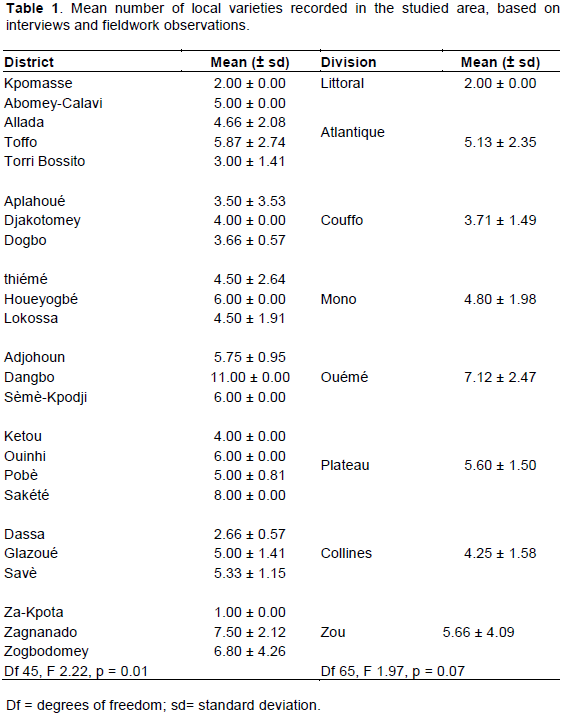
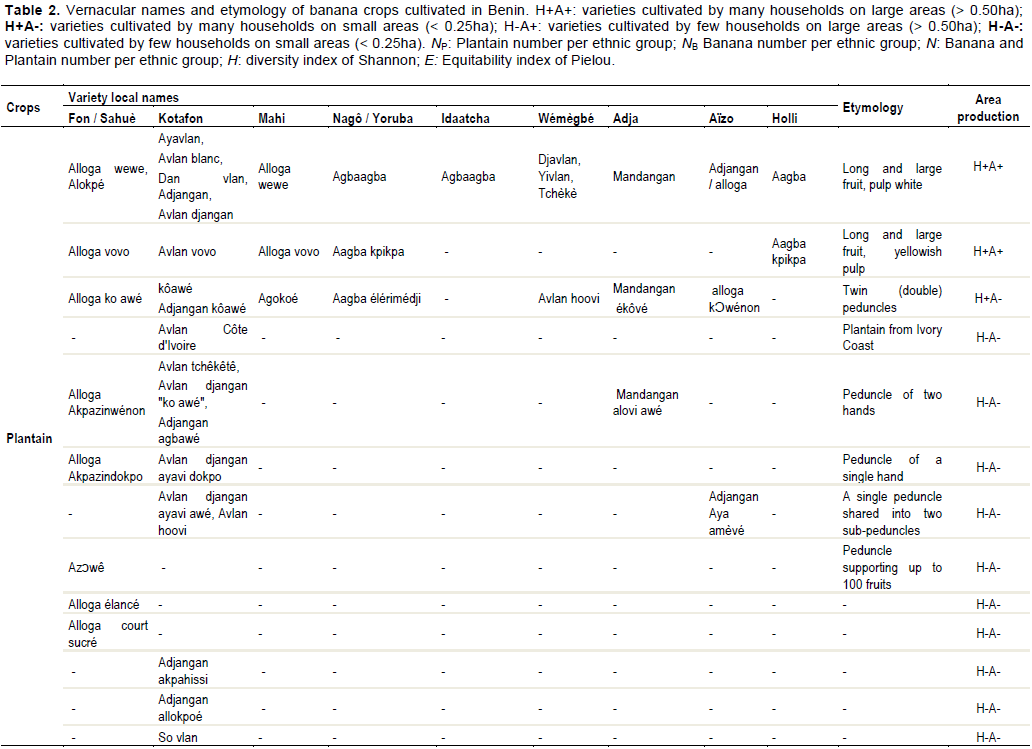

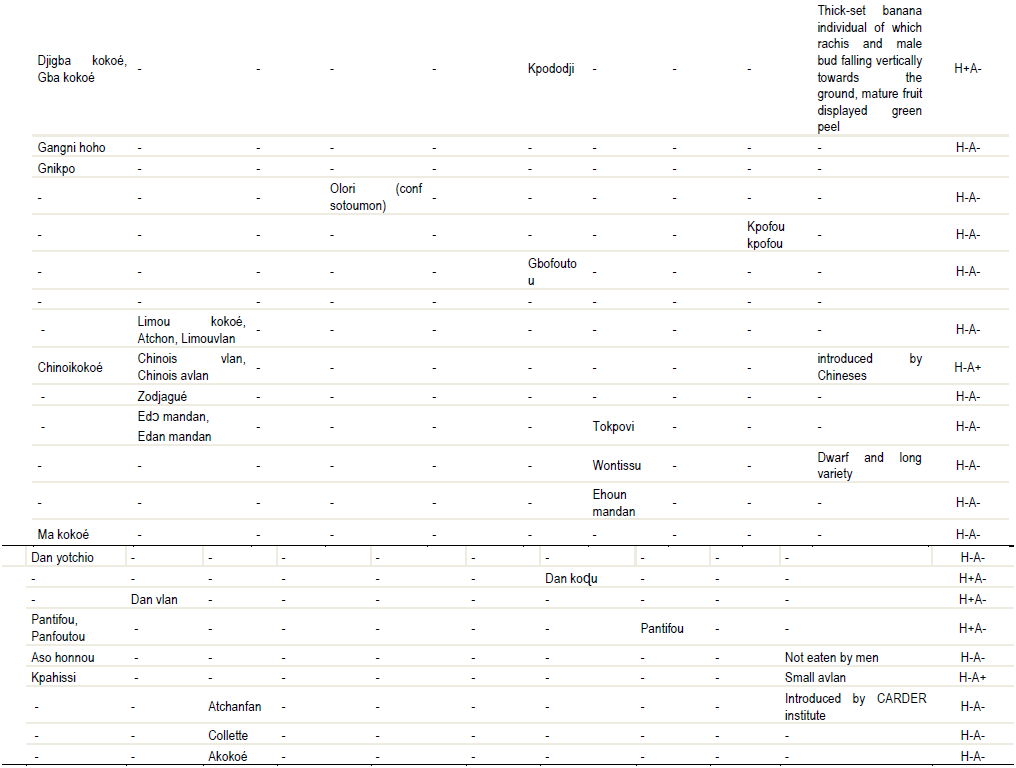

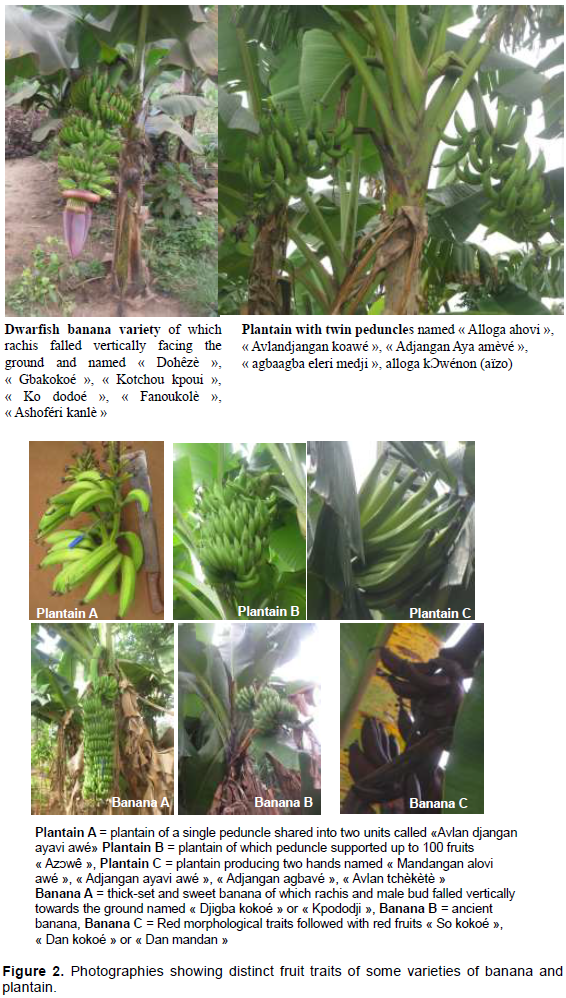
Farmers' perceptions of constraints to dessert banana and plantain production
Banana and plantain were mainly cultivated in lowland and along riversides where it found favourable growing conditions (appropriate rainfall and temperature). However, there was a substantial yield decline and reduction in plantation life due to water availability and pests and diseases especially in the eastern sites of Benin. Fourteen biotic and abiotic constraints were reported as main causes for the decline of banana and plantain genetic resources. Farmers identified susceptibility to drought (23.8% of responses), stealing of the whole bunches (19.0%), pests and diseases (14.3%), susceptibility to flood (9.5%) and break of pseudostem break by wind (7.8%) as the major production constraints (Figure 3). Many criteria were used by farmers in the choice of varieties to put into production. The first criterion was related to the market value of the variety. Taking into account this criterion, plantain varieties appeared to be more expensive than dessert banana. However, the importance of productivity (big bunch supporting many fruits), good taste of the fruit and preferred landraces by consumers, and medicinal uses were factors of preserving varieties. Farmers observed that pest damage was more severe when soil fertility is poor. Farmers used various chemical products to destroy pests. To value the empty space between individuals and improve farmers’ incomes, banana dessert and plantain productions were often associated with various cereals especially maize (Zea mays) and other food crops such as cassava (Manihot esculenta), groundnut (Arachis hypogea), watermelon (Citrullus lanatus), tomato (Lycopersicon esculentum), chilli (Capsicum annuum), potato (Ipomoea batatas), and taro (Colocasia esculenta).
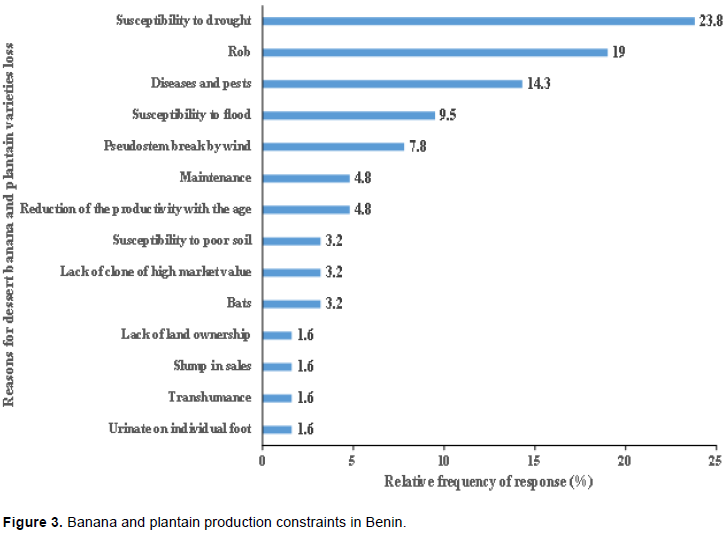
Uses
People used banana and plantain in four main categories: dessert and food (52%), traditional medicine (19%), handicraft (13%) and social well-being (10%) and others (6%). Bunch was often kept on individual plants until fruit maturation before its harvest. Hand fruits were then detached from rachis; banana ripening stepped up under the lee of light in the open air, or it was packed in other plant species’ leaves such as Musa spp., Spondias mombin, Albizia adianthifolia, Azadirachta indica, Olax subscorpioides, Lonchocarpus sericeus within tins or pots including immature tree fruits of Irvingia gabonensis, Adenopus breviflorus, Elaeis guineensis. All ethnic groups from South Benin added carbide within packages to accelerate fruit maturation but plantain often displayed black stains on the fruit pericarp.
Mature sweet banana (yellow or white pulp, according to variety) was edible and considered as dessert, while plantain was also consumed as dessert (mature fruit) as well as energetic food (mature and immature fruit). Indeed for sweet banana, fresh pulp is directly consumed as dessert (all varieties), cooking (variety Sotoumon), as well as processed in fried pasta called « talé talé » or as porridge flour for children (varieties Sotoumon, kpokokpoko and Planta). Plantain pulp is edible and consumed fresh as dessert or roasted, cooked and pounded alone or in combination with manioc, fried or processed in « talé talé ». Some variety leaves were used as wrapping for hot (akassa, cake, ablô) and cold food (banana, kola) as well as for buildings and for home clay construction. The banana’s peel was used to repulse shrews in rural area. Banana was widely used to treat various diseases in medicinal plans. The frequent diseases are described in Table 3.
A total of 122 vernacular names were used to name 58 local varieties of dessert banana and plantain through the nine ethnic groups surveyed, supplying the documentation of these crops names in Benin in comparison with the 113 ones from Togo (Koukouma et al., 2016). Indeed, natural reproductive barriers often occurred within Eumusa species from spontaneous chromosome structural changes or recombination events causing subspecies divergence and genetic diversity. African plantains are commonly hybrid triploids (AAB) (Daniells et al., 2001) while dessert banana are diploid, triploids and tetraploids, matching with the high diversity recorded especially in banana used for dessert (Ortiz, 2013).
Some of the vernacular names resulted from discriminant morphological, agronomical and cultural traits that appeared to be similar in several ethnic groups living, or not, in the same geographical area. This suggested a high level in the local taxonomy of these crops. Some of these criteria were commonly used elsewhere as well as in vernacular taxonomy as used for agro morphological characterization (Koukouma et al., 2016; Kodjo and Adheka, 2015; Daniells et al., 2011; Sweenen et al., 1995). However, criteria such as unedible fruit, ancestral banana and medicinal uses confirm the character of plant used as a discriminant trait for varietal identification since antiquity (Spichiger et al., 2000).
Banana and plantain varieties required agro-morphological studies
In spite of their traditional morphological descriptors for folk classification based on local knowledge, the 58 local varieties recorded by the ethnobotanical survey cannot express the real varietal diversity of plantain and dessert banana in Benin due to the ploidy status and the probable synonymy and homonymy within and among ethnic groups. Moreover, some mutations such as twin peduncles or three peduncles within an individual are thought to be irregular varying with environmental conditions (Kodjo and Adheka, 2015). Thus, agro-morphological studies combined with molecular analysis are required to confirm the gathering of bananas varieties.
Our results identified some southern ethnic groups producing most local varieties due to the high rainfall conditions favorable to the development of banana species in the South. Moreover, considering socio-economic impacts, south of Benin is the most populated region where demand for agricultural products (including banana and plantain) is higher than elsewhere. These crops’ socioeconomic values were so high that wholesalers deposited some money to producers before fruit harvest in this South region. In addition to the introduced varieties from other countries such as Gambari’s banana or Ghana’s banana, some local varieties identified in Benin have already been described elsewhere: plantain of peduncle with one hand viewed as a very loose bunch: plantain with twin peduncles (named Douala variety in Cameroon (Kodjo et al., 2015).
Factors affecting banana and plantain production
In spite of susceptibility to drought (23% of responses), in contrast to other crops such as cereals, plantain is considered as a good biological plant species candidate adapted to climate change because a temperature increase of 3°C remained favorable for their development (Calberto et al., 2016). Banana and plantain are easy to produce, implying their plantations and production can be beneficial in association with other crops in various environments including home gardens. However, a main handicap for these crops’ production remains the quality of suckers (Meutchieye, 2009; Meunier et al., 2011). Most collections of these suckers originated from plantations of old-age often inherited or personal (after 1-2 generations). Such plantations are subjected and vulnerable to pests and diseases (nematodes and the foliar disease, black sigatoka), which spread rapidly reducing yield (Meutchieye, 2009). All banana and plantain varieties from the two administrative Divisions from East Benin (Oueme and Plateau) are currently infested by the Banana Bunchy Top Virus (BBTV), and no cultivars can be collected for conservation. Whether market gardening is associated with these crops for land covering, organic matter supply and to avoid erosion, a high interaction through water requirement is reported when cassava is produced with banana and plantain (Meunier et al., 2011). The regular theft of these staple food crops is commonly described, exhibiting the high poverty line and the importance of growing awareness on the need for more prosperous occupations.
Implications of diseases and fruit maturation on human well-being
The use of chemical pesticides is noxious for human health and environment. Likewise, the maintenance of heat within a vase appeared as a fluent condition for fruit maturation using a relative quantity of various plant leaves. However the addition of chemical components especially carbide in South of Benin must be prohibited through awareness campaigns. Infested leaves, flowers, bunches, individuals and suckers must be removed and their wastes must be burnt out of plantations.
Our survey revealed a total of 58 cultivated varieties of banana and plantain from 122 vernacular names through nine ethnic groups from the centre and south of the country. This diversity cannot express the real varietal diversity of plantain and dessert banana in Benin due to the ploidy status and the probable synonymy and homonymy within the same ethnic group, requiring agro-morphological studies combined with molecular analyses to clarify their taxonomic status. This presents an advantage at identifying varieties, although abnormally gathered within the same name, apart from the issues of etymology. The vernacular name of these crops has relied on agro-morphological characters. Most varieties were cultivated by a few households on small areas defining their vulnerability status. In situ and ex situ conservation should be undertaken to preserve the entire diversity due to the high rate of variety loss.
The authors have not declared any conflict of interests.
Financial support was provided by Fonds National de la Recherche Scientifique et de l’Innovation Technologique (FNRSIT) through the project (Convention N° 06/MESRS/FNRSIT/SSE/SA du 03/02/2016). Authors also thank producers for their contribution during the surveys.
REFERENCES
|
Calberto G, Staver C, Siles P (2016). An assessment of global banana production and suitability under climate change scenarios. In: Food and Agriculture Organization of the United Nations FAO Climate change and food systems: global assessments and implications for food security and trade (ed. Elbehri A.) pp. 265-291.
|
|
|
|
Crouch JH, Vuylsteke D, Ortiz R (1998). Perspectives on the application of biotechnology to assist the genetic enhancement of plantain and banana (Musa spp.). Electronic Journal of Biotechnology 1:1-18.
Crossref
|
|
|
|
|
Daniells J, Jenny C, Karamura D, Tomekpe K (2001). Musalogue: a catalogue of Musa germplasm. Diversity in the genus Musa (E. Arnaud and S. Sharrock, compil.). International Network for the Improvement of Banana and Plantain, Montpellier, France.
|
|
|
|
|
Debabandya M, Sabyasachi M, Namrata S (2010). Banana and its by-product utilization: an overview. Journal of scientific and Industrial Research 69:323-329.
|
|
|
|
|
FAOSTAT (2016). Database. Food and Agriculture Organization, Roma, Italy. Avaible at: www.fao.org
|
|
|
|
|
Frontier S, Pichod-Viale D (1995). Théorie des ecosystèmes: Structure fonctionnement, évolution, 2è édition. Collection d'écologie 21:287-311.
|
|
|
|
|
Hamilton AC, Karamura D, Kakudidi E (2016). History and conservation of wild and cultivated plant diversity in Uganda: Forest species and banana varieties as case studies. Plant Diversity 38:23-44.
Crossref
|
|
|
|
|
Happi ET, Andrianaivo RH, Wathelet B, Tchango Tchango J, Paquot M (2007). Effects of the stage of maturation and varieties on the chemical composition of banana and plantain peels. Food Chemistry 103:590-600.
Crossref
|
|
|
|
|
Jenny C, Carreel F, Tomekpe K, Perrier X, Dubois C, Horry JP, Tezenas DU, Montcel H (2003). Banana. In : Genetic diversity of cultivated tropical plants. Montpellier, France, CIRAD pp. 99-124.
|
|
|
|
|
Kodjo E, Adheka I (2015). Regional workshop on african plantain characterization. Africa Research Center on Bananas and Plantains (CARBAP) 11th -16th May, Njombé, Cameroun.
|
|
|
|
|
Koukouma R, Yedomonhan H, Dansi A, Adjatin A, Agre P (2016). Diversity and Management of Banana and Plantain (Musa spp.) Varieties in Togo. International Journal of Current Research in Biosciences and Plant Biology 3(2):127-138.
Crossref
|
|
|
|
|
Lassoudière A (2007). Le bananier et sa culture. Quaeversailles 5(2):1-383.
|
|
|
|
|
Lescot T (2011). La diversité génétique des bananiers. FruiTrop 89:58-62.
|
|
|
|
|
Lescot T (2006). La banane en chiffres, le fruit préféré de la planète. FruitTrop 140:5-9.
|
|
|
|
|
Meunier Q, Lassois L, Doucet J-L (2011). Guide de plantation et de conduite d'une bananeraie agroforestière en milieu rural au Gabon. DACEFI-2: Développement d'Alternatives Communautaires à l'Exploitation Forestière illégale (seconde phase) P 32.
|
|
|
|
|
Meutchieye F (2009). Fiche Technique de multiplication des bananiers par la méthode de PIF Plants Issus de Fragments de tiges. Manuel de formation pour les communautés rurales. TerrEspoir Cameroun P 15.
|
|
|
|
|
Ongagna A, Mialoundama F, Bakouetila MGF (2016). Etude de la production des plants de bananiers et plantains (Musa spp.) par la technique des PIF au Congo: Effets des substrats sur la croissance et le développement des plants en pépinière. International Journal of Neglected and Underutilized Species 2:42-56.
|
|
|
|
|
Ortiz R (2013). Conventional banana and plantain breeding. Acta horticulturae 986 (986):177-194.
Crossref
|
|
|
|
|
Spichiger RE, Savolainen VV, Figeat M (2000). Botanique systématique des plantes: Une approche phylogénétique nouvelle des Angiospermes des régions tempérées et tropicales. Première édition. P 373.
|
|
|
|
|
Sweenen R, Vuylsteke D, Ortiz R (1995). Phenotypic diversity and patterns of variation in West and Central African Plantains (Musa spp., AAB group Musaceae). Economic Botany 49(3):320-327.
Crossref
|
|
|
|
|
Tomepke K (2006). La banane plantain en Afrique. Fruit Spécial issue P 5.
|
|
|
|
|
Venables WN, Smith DM (2010). An Introduction to R. Notes on R: A Programming Environment for Data Analysis and Graphics. Version 2.12.1.
|
|